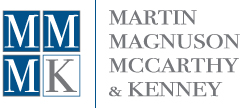The Supreme Judicial Court Overturns Chevron Ruling Impacting State and Regulatory Systems Nationwide
The Supreme Judicial Court Overturns Chevron Ruling Impacting State and Regulatory Systems Nationwide
Client Update
On June 28, 2024, the Supreme Court overruled Chevron, a case which for 40 years provided the framework for courts to interpret statutes administered by federal agencies. The Chevron doctrine informed judicial review of agency interpretation of statutory language by requiring deference to agency interpretations where a statute was ambiguous or silent and the interpretation was a permissible interpretation of the statute. Now in its place is the new Loper Bright doctrine which requires courts to exercise independent judgment when deciding if an agency has acted within its statutory authority.
Just three days later, on July 1, 2024, the Supreme Court issued another blow to the changing administrative law landscape in the Corner Post decision. The Court held that the statute of limitations to challenge final agency action under the Administrative Procedure Act (“APA”) is no longer six years from the final action itself, rather six years from when a plaintiff is actually injured by that action. This decision essentially allows for an indefinite time frame in which final agency actions can be challenged.
The new Loper Bright standard and the decision in Corner Post have placed administrative law in uncharted territory but not necessarily to the benefit of those businesses being regulated.
Out With the Old: Chevron and its Legacy
Cited in over 20,000 decisions, Chevron has been undeniably impactful. The Chevron case centered on the issue of whether the EPA’s decision to allow states to treat all pollution-emitting devices within the same industry group as if within a single “bubble” was based on a reasonable construction of the statute. The Court found that the EPA’s definition of the term “source” was a permissible interpretation of the statute that sought to allow progress in reducing air pollution associated with economic growth. This conclusion was reached by reviewing the EPA’s various interpretations of “source” over time which showed it was consistently viewed as flexible in the context of implementing policy decisions in a technical, complex area.
In Chevron, the Court more broadly held that where a statute is ambiguous, but a reasonable interpretation has been made by the administrator of an agency, a court cannot replace the agency’s construction with its own interpretation of the statute. From this holding, the Chevron doctrine was born in which deference to agency interpretation was assumed. Applying Chevron included two main steps:
1. Determining whether Congress had directly spoken to the exact question at issue; and
2. If Congress had not spoken directly on the issue, upholding the agency’s interpretation so long as it was a “reasonable” construction of the statute.
This doctrine led to an increase in the power administrative agencies wielded.
In With the New: The Loper Bright Doctrine
The main issue in Loper Bright was whether the Chevron doctrine should be overruled, and the Court answered in the context of a case dealing with the administration of the Magnuson-Stevens Fishery Conservation and Management Act (MSA) by the National Marine Fisheries Service (NMFS) who has power under delegation from the Secretary of Commerce. The Court held Chevron must be overruled as the deference it affords prevents courts from exercising the judicial power to say what the law is which was given to them by Article III of the Constitution.
The Court further held that not only must courts exercise their independent judgment in making the assessment of whether an agency has acted within the limits of its delegated power, but the Administrative Procedure Act (APA) requires it. The majority in Loper Bright argued the text of the APA gives federal courts the power to do the following:
- Decide all relevant questions of law;
- Interpret constitutional and statutory provisions; and
- Determine the meaning and applicability of terms of an agency action
The Court asserts that when combined, these powers mean courts must not take agency constructions of law at face value and instead need to draw their own, independent conclusions.
Ultimately, the Court is ushering in a new era in which agency interpretations are no longer given default deference as a result of the special knowledge and position of such agencies to interpret Congress’s meaning in enacting a statute. While the landscape of regulatory litigation will not change overnight, as Justice Gorsuch said in his concurrence of Loper Bright, the decision effectively put “a tombstone on Chevron no one can miss.”
Corner Post was decided on the heels of Loper Bright and will likely compound the destabilizing effect on the administrative state. Taken together, these cases open the door to a significant increase of regulatory challenges. While prior to Corner Post federal agency regulations were insulated from review six years after their publication, now they may be challenged at any time as any newly created entity now subject to the regulation or existing entity that suffers a first-time injury under the regulation will have grounds to challenge it.
Corner Post in practice allows for the challenging of federal agency regulations at nearly any time and such challenges will now be assessed according to the Loper Bright doctrine. While the nature of the impact depends on the number and type of lawsuits brought, there is no doubt agencies will likely be more cautious in rulemaking, decisions, and statutory interpretations.
Role of Agencies Post-Chevron
Although agency interpretations no longer have Chevron deference, until a court overturns them, they are functioning rules that regulated entities must abide by. Three main ways agencies may continue to inform the law are by:
1. Administering the law which allows agencies to control its meaning to an extent;
2. Using the executive influence to inform the legislative agenda and engage in the legislative process; and
3. Offering their expertise in drafting legislation.
Chevron and OSHA
Challenges to OSHA are not new, but in the post-Chevron world they have the potential for devastating impacts if successful. Recently, the Supreme Court declined to hear the Allstate Refractory case which sought a decision on whether the grant of power given to OSHA to create and impose any workplace standard it views as reasonably necessary was an unconstitutional delegation of legislative authority. In his dissent to the Court’s decision to refuse to hear the case, Justice Thomas expressed that OSHA may be the largest delegation of authority to administrative agency. Further, Thomas shares in the concerns of those who sought to bring the case: that such power is meant to be reserved solely for the legislature.
This is not the first, and is unlikely to be the last, challenge to OSHA’s authority, particularly with the new Loper Bright doctrine in play. The potential for OSHA’s power to be diminished through such challenges poses a threat to the industries OSHA regulates. OSHA regulations not only aid in protecting workers from hazards, but they provide safe harbors for businesses and a set system of known rules which can be easily ascertained. A successful challenge to OSHA’s regulatory power would mean returning to a system of fragmented safety standards and a minefield of potential violations and lawsuits.
Although a lack of sure regulations may appear as a ‘win’ to some as it creates a gray area to operate in, this gray area leaves regulated entities vulnerable. Agency regulations provide a standard and guide those who are bound to abide by them. Meeting such standards can act as a defense for regulated entities who are sued and protect both consumers and regulated entities from harm. Consistency also allows entities to know when they are compliant and when they are clearly breaking the rules. Without such a clear line, regulated entities may lack proper information on what the law requires and unknowingly fail to adhere to it.
Regulated entities should stay apprised of developing challenges to agencies that regulate their industry, particularly OSHA, as it is anticipated that there will be an uptick in regulatory litigation because of the Loper Bright and Corner Post decisions. Returning to a patchwork system of regulatory law poses a significant risk to regulated entities and consumers alike.
How We Can Help
- Agencies may be more amendable to input from businesses and trade groups to lessen challenges to regulation. We can help advocate for reasonable standards.
- Businesses will need to keep apprised of agency challenges and an anticipated growing importance to and variation in state regulatory laws.
- Businesses may need to develop litigation strategies that rely on their independent review of scientific and trade literature rather than waiting for agency guidance.
Our Attorneys
-
Taylor R. Alcorn
-
Jennifer A. Creedon
-
Darlene Dawson
-
Sarah Bandomer Greenhalgh
-
Alexis Harrington
-
Paul R. Keane
-
Michael J. Keefe
-
Jennifer E. Kogan
-
Edward F. Mahoney
-
Lauren Mankowski
-
Paul M. McTague
-
Steve O’Shea
-
Caroline A. Ottoboni
-
Charles P. Reidy III
-
Kevin C. Reidy
-
Joan F. Renehan
-
Douglas A. Robertson
-
Lindsey Taylor
-
Lindsay Weber
-
Kathleen O’Donnell Wyatt
MMM&K has obtained more than 100 jury trial verdicts in favor of our clients.
Our partners combine more than 250 years
of collective litigation experience.









